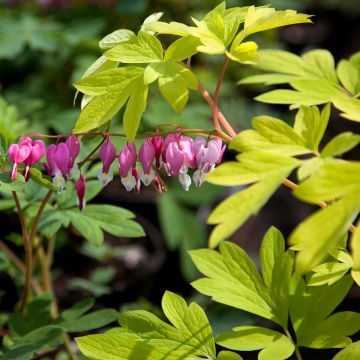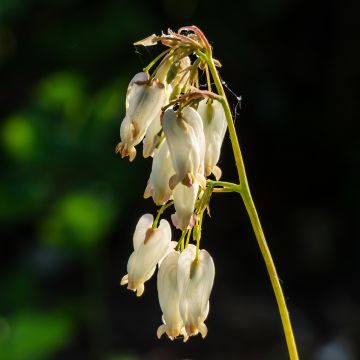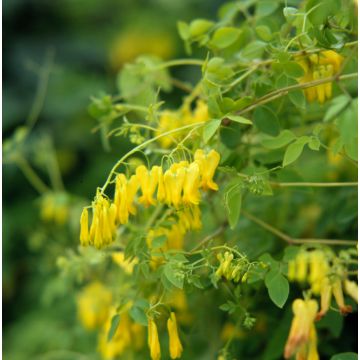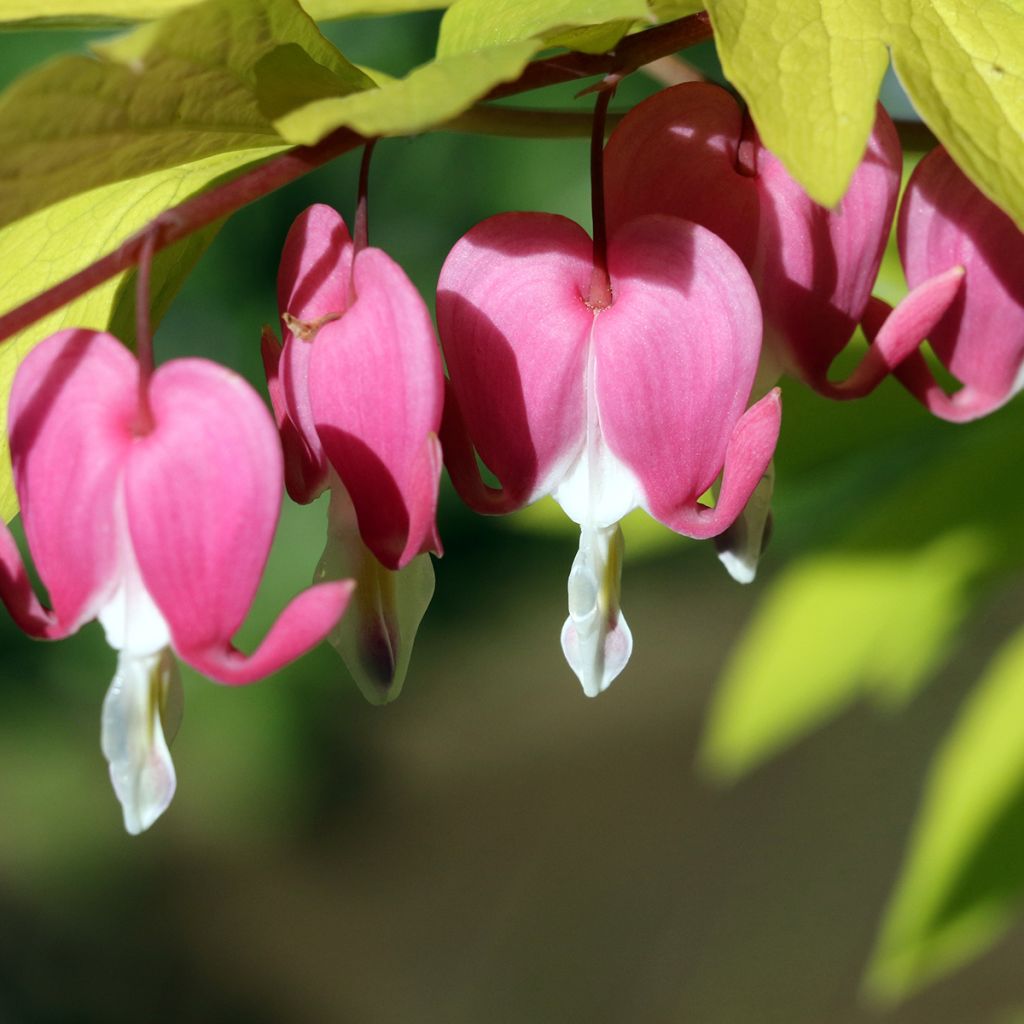

Dicentra spectabilis Goldheart


Dicentra spectabilis Goldheart


Dicentra spectabilis Goldheart
Dicentra spectabilis Goldheart
Dicentra spectabilis Goldheart®
Bleeding Heart, Lyre Flower, Lady in a Bath
Why not try an alternative variety in stock?
View all →This plant carries a 12 months recovery warranty
More information
We guarantee the quality of our plants for a full growing cycle, and will replace at our expense any plant that fails to recover under normal climatic and planting conditions.
From €5.90 for pickup delivery and €6.90 for home delivery
Express home delivery from €8.90.
From €5.90 for pickup delivery and €6.90 for home delivery
Express home delivery from €8.90.
From €5.90 for pickup delivery and €6.90 for home delivery
Express home delivery from €8.90.
Does this plant fit my garden?
Set up your Plantfit profile →
Description
Golden Bleeding Heart or Dicentra spectabilis Goldheart is a vigorous perennial with strong roots ideal for brightening a shady corner in spring thanks to its golden yellow foliage. Curved inflorescences with bright pink and white heart-shaped pendulous flowers appear from May to June, creating a stunning contrast with its foliage. During the summer, it enters dormancy, losing its foliage.
The Golden Bleeding Heart reaches 60 cm (24in) high and thrives in woodland environments. It easily grows under deciduous trees with soil that is moist in spring.
Dicentra spectabilis Goldheart has the same qualities as the species. It likes partial shade and deep, rich, and well-drained soils without excessive water, and is highly cold-resistant. Its little hearts add a charming touch to any spring border.
Behind colourful foliage like Purple Heucheras, and alongside Astrantias, Columbines, and tulips with a few cowslips in the foreground, it's a marvel! Most Bleeding Hearts go dormant at the end of spring, but this has no detrimental effect.
Report an error about the product description
Dicentra spectabilis Goldheart in pictures
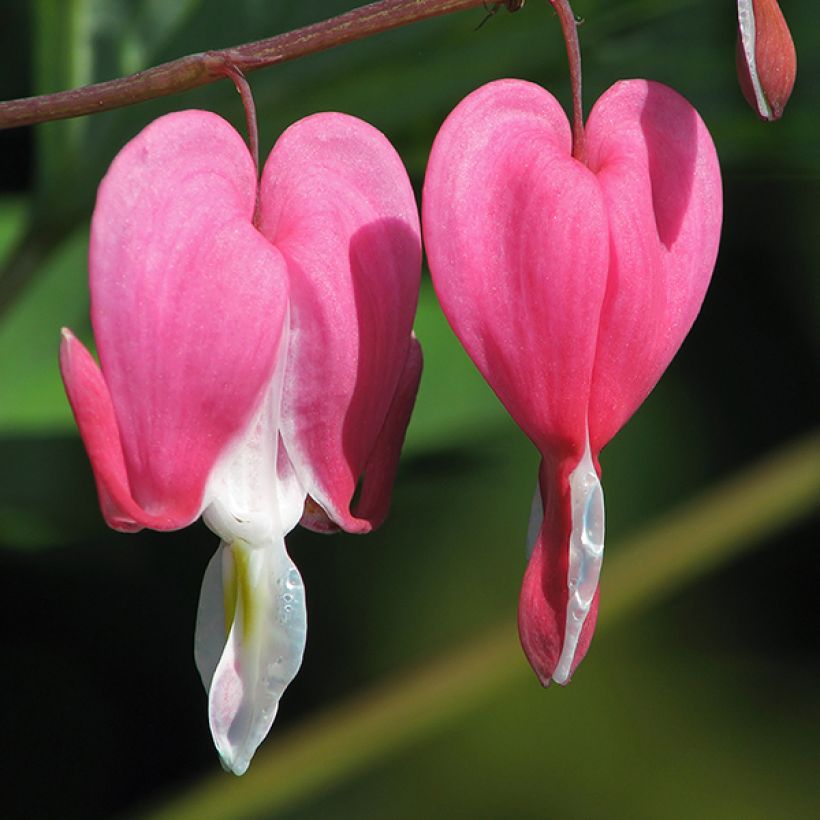



Flowering
Foliage
Plant habit
Botanical data
Dicentra
spectabilis
Goldheart®
Papaveraceae (Fumariaceae)
Bleeding Heart, Lyre Flower, Lady in a Bath
Cultivar or hybrid
Other Dicentra - Bleeding Hearts
Planting and care
'Goldheart' Bleeding Heart (Dicentra spectabilis, now called Lamprocapnos spectabilis) is a perennial plant of cool understory in Asia, enjoying partial shade or light sun.
Its fleshy crown needs good garden soil to develop well: well-drained, humus-bearing, rich, and light. It can rot in clayey and heavy soil. It also does not like hot conditions and dry soil.
It is a plant that undergoes summer dormancy: after flowering in spring, the Bleeding Heart falls asleep with the first heat, and all its above-ground parts dry up and disappear until the following spring. This is completely normal and allows this species to survive the hottest periods without problems.
If your soil is too poor or sandy, you can add a good layer of dead leaves in autumn, which will enrich and loosen your beds after a few years. Avoid synthetic fertilizers that only enrich the soil in the short term.
Weekly watering is recommended during the first summer to aid establishment. Stop watering when the leaves turn yellow and disappear.
The tender leaves of the Bleeding Heart are also quite sensitive to slugs and snails at the beginning of growth. Place ashes, eggshells, or other organic barriers around the crown.
Planting period
Intended location
Care
-
, onOrder confirmed
Reply from on Promesse de fleurs
Spring flowering perennials
Haven't found what you were looking for?
Hardiness is the lowest winter temperature a plant can endure without suffering serious damage or even dying. However, hardiness is affected by location (a sheltered area, such as a patio), protection (winter cover) and soil type (hardiness is improved by well-drained soil).

Photo Sharing Terms & Conditions
In order to encourage gardeners to interact and share their experiences, Promesse de fleurs offers various media enabling content to be uploaded onto its Site - in particular via the ‘Photo sharing’ module.
The User agrees to refrain from:
- Posting any content that is illegal, prejudicial, insulting, racist, inciteful to hatred, revisionist, contrary to public decency, that infringes on privacy or on the privacy rights of third parties, in particular the publicity rights of persons and goods, intellectual property rights, or the right to privacy.
- Submitting content on behalf of a third party;
- Impersonate the identity of a third party and/or publish any personal information about a third party;
In general, the User undertakes to refrain from any unethical behaviour.
All Content (in particular text, comments, files, images, photos, videos, creative works, etc.), which may be subject to property or intellectual property rights, image or other private rights, shall remain the property of the User, subject to the limited rights granted by the terms of the licence granted by Promesse de fleurs as stated below. Users are at liberty to publish or not to publish such Content on the Site, notably via the ‘Photo Sharing’ facility, and accept that this Content shall be made public and freely accessible, notably on the Internet.
Users further acknowledge, undertake to have ,and guarantee that they hold all necessary rights and permissions to publish such material on the Site, in particular with regard to the legislation in force pertaining to any privacy, property, intellectual property, image, or contractual rights, or rights of any other nature. By publishing such Content on the Site, Users acknowledge accepting full liability as publishers of the Content within the meaning of the law, and grant Promesse de fleurs, free of charge, an inclusive, worldwide licence for the said Content for the entire duration of its publication, including all reproduction, representation, up/downloading, displaying, performing, transmission, and storage rights.
Users also grant permission for their name to be linked to the Content and accept that this link may not always be made available.
By engaging in posting material, Users consent to their Content becoming automatically accessible on the Internet, in particular on other sites and/or blogs and/or web pages of the Promesse de fleurs site, including in particular social pages and the Promesse de fleurs catalogue.
Users may secure the removal of entrusted content free of charge by issuing a simple request via our contact form.
The flowering period indicated on our website applies to countries and regions located in USDA zone 8 (France, the United Kingdom, Ireland, the Netherlands, etc.)
It will vary according to where you live:
- In zones 9 to 10 (Italy, Spain, Greece, etc.), flowering will occur about 2 to 4 weeks earlier.
- In zones 6 to 7 (Germany, Poland, Slovenia, and lower mountainous regions), flowering will be delayed by 2 to 3 weeks.
- In zone 5 (Central Europe, Scandinavia), blooming will be delayed by 3 to 5 weeks.
In temperate climates, pruning of spring-flowering shrubs (forsythia, spireas, etc.) should be done just after flowering.
Pruning of summer-flowering shrubs (Indian Lilac, Perovskia, etc.) can be done in winter or spring.
In cold regions as well as with frost-sensitive plants, avoid pruning too early when severe frosts may still occur.
The planting period indicated on our website applies to countries and regions located in USDA zone 8 (France, United Kingdom, Ireland, Netherlands).
It will vary according to where you live:
- In Mediterranean zones (Marseille, Madrid, Milan, etc.), autumn and winter are the best planting periods.
- In continental zones (Strasbourg, Munich, Vienna, etc.), delay planting by 2 to 3 weeks in spring and bring it forward by 2 to 4 weeks in autumn.
- In mountainous regions (the Alps, Pyrenees, Carpathians, etc.), it is best to plant in late spring (May-June) or late summer (August-September).
The harvesting period indicated on our website applies to countries and regions in USDA zone 8 (France, England, Ireland, the Netherlands).
In colder areas (Scandinavia, Poland, Austria...) fruit and vegetable harvests are likely to be delayed by 3-4 weeks.
In warmer areas (Italy, Spain, Greece, etc.), harvesting will probably take place earlier, depending on weather conditions.
The sowing periods indicated on our website apply to countries and regions within USDA Zone 8 (France, UK, Ireland, Netherlands).
In colder areas (Scandinavia, Poland, Austria...), delay any outdoor sowing by 3-4 weeks, or sow under glass.
In warmer climes (Italy, Spain, Greece, etc.), bring outdoor sowing forward by a few weeks.

































